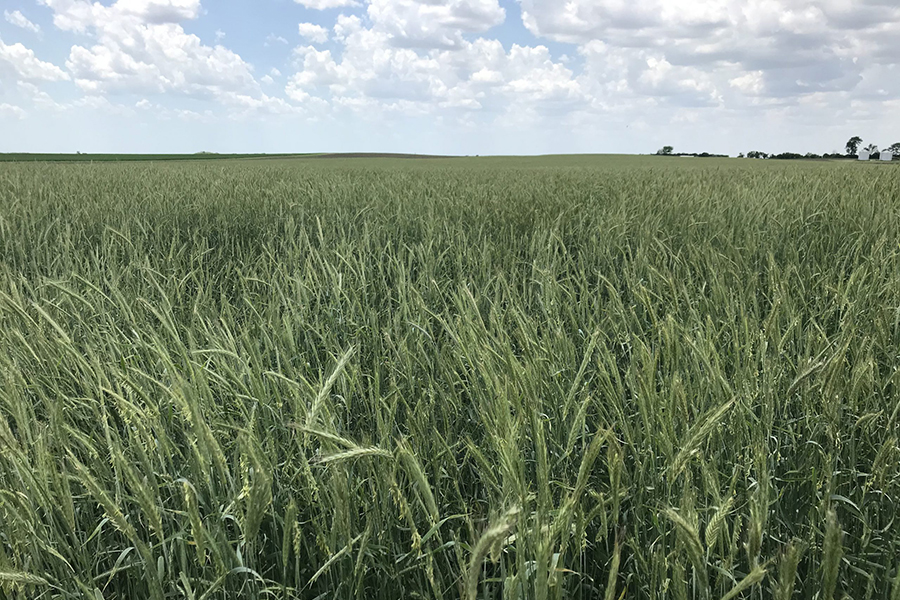by Margaret Smith, PhD Forage & Organic Agronomist
Using winter rye for weed suppression in organic no-till soybeans is moving from novelty status to a proven practice. There are still a lot of nuances to this technique, with various production aspects still being researched, tested, and refined. Even so, more and more organic producers are trying and adopting this practice.
Below are some suggested practices for success with this system.
Crop Rotation
Plant rye following a short-season crop, such as oats, peas, sweet corn or silage corn to accommodate early planting. (Results following corn harvested for grain have been poor. This rotation sequence may work with longer growing seasons in southern Iowa, central Illinois, and farther south.) Avoid growing wheat for milling after these soybeans; volunteer rye can contaminate the wheat crop.
Biomass Production Goal
Heavy rye biomass production the spring following planting is one of the keys to success with this system. The objective is to grow 8,000 to 10,000 of dry rye biomass at anthesis to fully mulch the soybeans and suppress weed growth.
Biomass production is a function of rye variety, seeding rate, seeding date, adequate fertility (particularly N), and growing conditions.
Rye Variety Selection
Researchers in Wisconsin and experienced farmers in the Upper Midwest have had success with the varieties Spooner, Aroostook, ND-Gardner and Elbon. Other varieties may work, but head and shed pollen later than these varieties.
Rye Planting Date
Early! Drill or plant rye in September in the Upper Midwest—ideally, September 1-20, up to September 30. Avoid planting in the first half of August, though. Too much fall growth can contribute to rye winterkill. Move these calendar dates sooner in central Minnesota and northern Wisconsin, and later, south of central Wisconsin and northern Iowa.
Rye Seeding Rate
Seed rye at 2,225,000 to 3,000,000 seeds/A. (Work is ongoing to further evaluate this recommendation.) The lighter seeding rate may be appropriate with earlier planting (within the guidelines provided) and good nitrogen fertility status. (Nitrogen helps encourage rye tillering.) For later planting and with lower nitrogen fertility, use the higher seeding rate.
Rolling and Crimping the Rye
In the spring, roll and crimp the rye when 100% of the plants are shedding, or have shed, pollen (anthesis). Because rye varieties are composed of diverse genetic populations, when the last plants reach anthesis, some earlier plants will be more mature. Rolling before full anthesis will result in some plants “righting” themselves.
Some rye plants in this system can produce viable seed, which may volunteer later. These seed producing plants can be on either the early or late end of flowering. After waiting for the last plants to shed their pollen before crimping, the earliest flowering plants within the population may produce viable seed. On the other hand, if rolled and crimped too soon, those plants that right themselves may continue maturing and produce viable seed.
Soybean Planting
Plant soybeans at the same time—either just before or just after rolling the rye. Some farmers have had better success getting seed into the ground by planting soybeans into the standing rye first and immediately rolling after planting. If rolling and planting are separate operations, match equipment width and drive the same direction for both operations.
Other farmers have experimented with planting green about two weeks before rolling, with the objective to roll rye at anthesis when soybeans are between V1 and V3 growth stages. Disturbing rye earlier with the planter can delay maturity and spread the time period to achieve 100% anthesis. This planting window/timing has not yet been perfected.
Soybean Row Spacing and Planting Rate
Plant soybeans in 30-inch rows at 225,000 seeds/A. Excellent seed placement and covering may allow for lighter planting rates. When using this systems, monitor at-harvest soybean plant populations before lower these rates.
Some farmers use 15-inch rows spacing or drill their soybeans, but then give up the option, if needed, to run a cultivator with single sweep later in the season.
Planter Modifications
For planting soybeans AFTER rolling and crimping the rye cover crop, add weight or down-pressure to the planter.
Resources for rolled and crimped rye in organic soybean production:
We now have a lot of resources, as well as farmer experiences, to support these recommendations—with more available each year.
Wisconsin—University of Wisconsin Organic Program
Work of Dr. Erin Silva at the University of Wisconsin, Madison
- No-Till and Reduced-Till Organic – Ograin (wisc.edu) A video series on rolling and crimping rye and timing of soybean planting
- Video: Using the roller-crimper system with early planted emerged soybean – Integrated Pest and Crop Management – UW–Madison (wisc.edu)
- Slides presented at Purdue
- No-till Soybean Trial 2017. OGRAIN Factsheet 18-1 University of Wisconsin Organic and Sustainable Agriculture Research and Extension
- No-till Soybean Trial 2018. OGRAIN Factsheet 19-1 University of Wisconsin Organic and Sustainable Agriculture Research and Extension
- No-till and reduced till organic. OGRAIN Factsheets and Articles
Published research on the topic
New York—Cornell University
Iowa—Practical Farmers of Iowa
- Rolling Cover Crops and Soybean Row Widths, 2017 (Includes trials on both an organic and conventional farm)
- Soybean Row Width and Seeding Date When Using a Roller Crimper for Cereal Rye Cover Crop. 2018 (trial on an organic farm)
Illinois—Western Illinois University
Work of Dr. Joel Gruver at WIU at Macomb, IL
Indiana—Purdue University
Good summary from Michael O’Donnell at Purdue. He provides info for both organic and conventional operations.
USDA—Beltsville Maryland
Work of Dr. Steven Mirsky’s with the USDA Agricultural Research Service (ARS) at Beltsville, MD
Minnesota—Albert Lea Seed
Pennsylvania—Rodale Institute
Ontario, Canada—Ontario Ministry of Agriculture, Food, and Rural Affairs
South Dakota—South Dakota State University
- Soybean Rolling: Yield Effects Summary report of Iowa and Minnesota data generated in conventional soybean systems, with application for organic soybeans
